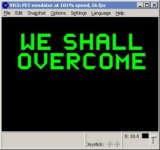Hi Dave. I still have it.
Stéphane.
Âllo Stéphane!
What we have been talking about among all the silliness is how to use the PET to test those suspicious ROM chips.
It doesn't matter now since you and Anders have sorted everything out, but if you want to try it just for fun and curiosity:
Put three of the spare ROMs into the empty sockets. Note which one is where.
Turn on the PET and enter this little program:
1 INPUT R:for I = R*4096 to I+4095:S=S+PEEK(I)

RINT S
Run the program 3 times, entering 9, 10 and 11; you should get 3 numbers, which are the sums of all the bytes in the three ROMS in sockets D3, D4 and D5 respectively.
If one of the ROMs is either 901474-02 or 901447-24 then change the 4095 to 2047 and run the program again, entering whichever number corresponds to the socket it's in; that's because the Exxx ROM is only 2KB in size vs. 4KB for all the rest (except the character generator, but we're not testing that).
Write down the numbers of the chips and their corresponding sums, and repeat for any other chips you want to check.
Here's a list of the ROM sizes and what the sums should be:
901439-01 2048 256095
901439-02 2048 274940
901439-03 2048 248466
901439-04 2048 258588
901439-05 2048 255230
901439-06 2048 269897
901439-07 2048 268936
901439-09 2048 255947
901447-01 2048 256095
901447-02 2048 255230
901447-03 2048 274940
901447-04 2048 269897
901447-05 2048 248466
901447-06 2048 258588
901447-07 2048 268936
901447-08 2048 97127
901447-09 2048 255947
901447-10 2048 97127
901447-24 2048 261567
901447-29 2048 297044
901465-01 4096 473144
901465-02 4096 479338
901465-03 4096 556184
901465-19 4096 478302
901465-20 4096 481632
901465-21 4096 500773
901465-22 4096 577305
901465-23 4096 475496
901474-01 2048 263658
901474-02 2048 289394
901474-03 2048 283274
901474-04 2048 283274
901498-01 2048 276306
901499-01 2048 276608
Have fun!

